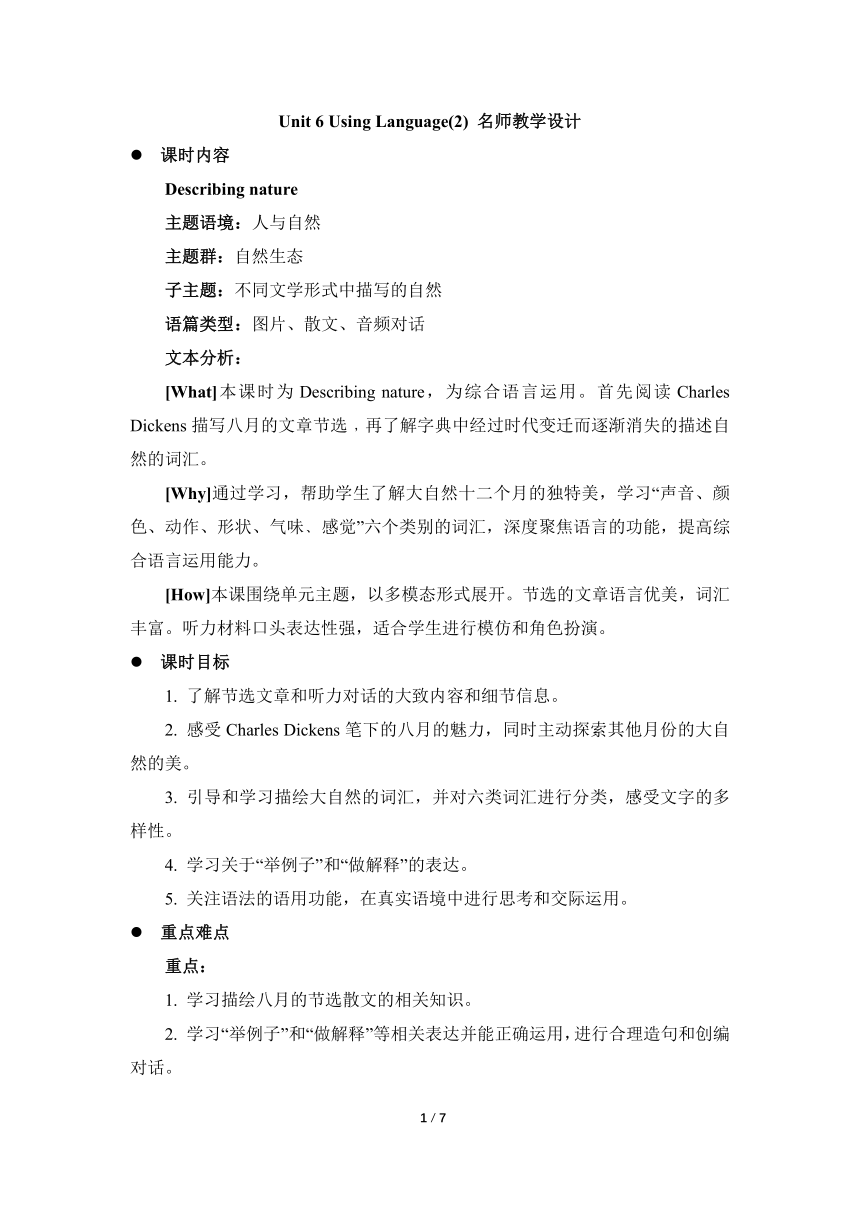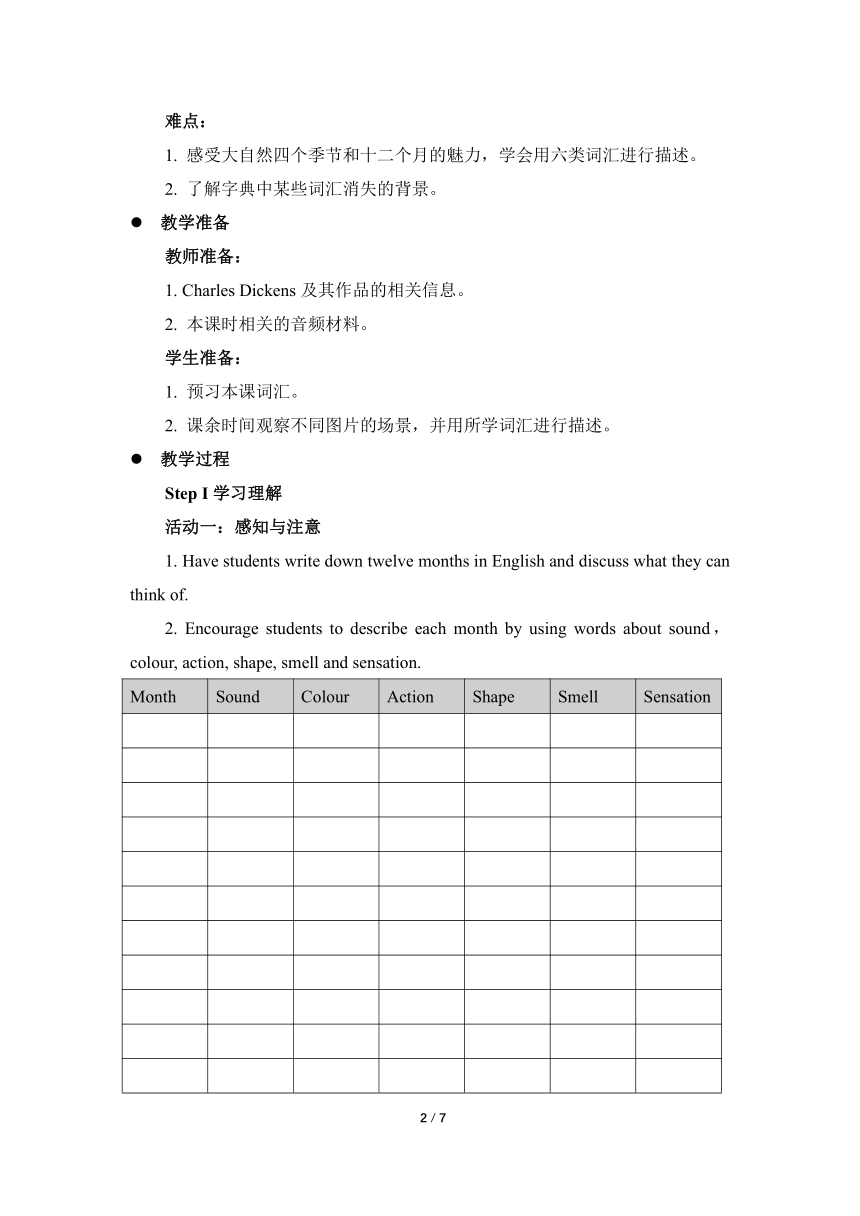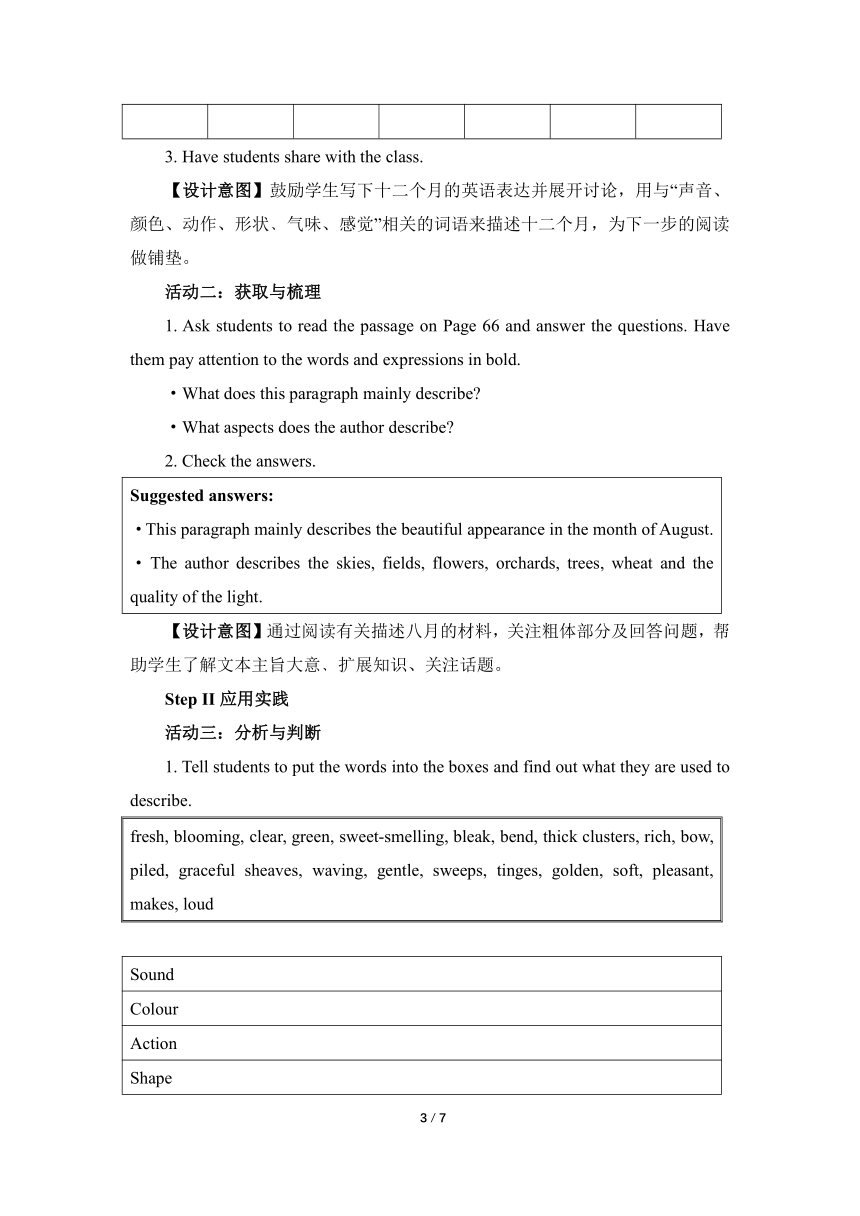外研版(2019)选择性必修第三册 Unit6 Nature in words Using Language(2) 名师教学设计
文档属性
| 名称 | 外研版(2019)选择性必修第三册 Unit6 Nature in words Using Language(2) 名师教学设计 |  | |
| 格式 | docx | ||
| 文件大小 | 23.1KB | ||
| 资源类型 | 教案 | ||
| 版本资源 | 外研版(2019) | ||
| 科目 | 英语 | ||
| 更新时间 | 2023-03-06 21:43:33 | ||
图片预览



文档简介
Unit 6 Using Language(2) 名师教学设计
课时内容
Describing nature
主题语境:人与自然
主题群:自然生态
子主题:不同文学形式中描写的自然
语篇类型:图片、散文、音频对话
文本分析:
[What]本课时为Describing nature,为综合语言运用。首先阅读Charles Dickens描写八月的文章节选﹐再了解字典中经过时代变迁而逐渐消失的描述自然的词汇。
[Why]通过学习,帮助学生了解大自然十二个月的独特美,学习“声音、颜色、动作、形状、气味﹑感觉”六个类别的词汇,深度聚焦语言的功能,提高综合语言运用能力。
[How]本课围绕单元主题,以多模态形式展开。节选的文章语言优美,词汇丰富。听力材料口头表达性强,适合学生进行模仿和角色扮演。
课时目标
1. 了解节选文章和听力对话的大致内容和细节信息。
2. 感受Charles Dickens笔下的八月的魅力,同时主动探索其他月份的大自然的美。
3. 引导和学习描绘大自然的词汇,并对六类词汇进行分类,感受文字的多样性。
4. 学习关于“举例子”和“做解释”的表达。
5. 关注语法的语用功能,在真实语境中进行思考和交际运用。
重点难点
重点:
1. 学习描绘八月的节选散文的相关知识。
2. 学习“举例子”和“做解释”等相关表达并能正确运用,进行合理造句和创编对话。
难点:
1. 感受大自然四个季节和十二个月的魅力,学会用六类词汇进行描述。
2. 了解字典中某些词汇消失的背景。
教学准备
教师准备:
1. Charles Dickens及其作品的相关信息。
2. 本课时相关的音频材料。
学生准备:
1. 预习本课词汇。
2. 课余时间观察不同图片的场景,并用所学词汇进行描述。
教学过程
Step I学习理解
活动一:感知与注意
1. Have students write down twelve months in English and discuss what they can think of.
2. Encourage students to describe each month by using words about sound, colour, action, shape, smell and sensation.
Month Sound Colour Action Shape Smell Sensation
3. Have students share with the class.
【设计意图】鼓励学生写下十二个月的英语表达并展开讨论,用与“声音、颜色、动作、形状﹑气味、感觉”相关的词语来描述十二个月,为下一步的阅读做铺垫。
活动二:获取与梳理
1. Ask students to read the passage on Page 66 and answer the questions. Have them pay attention to the words and expressions in bold.
·What does this paragraph mainly describe
·What aspects does the author describe
2. Check the answers.
Suggested answers: ·This paragraph mainly describes the beautiful appearance in the month of August. ·The author describes the skies, fields, flowers, orchards, trees, wheat and the quality of the light.
【设计意图】通过阅读有关描述八月的材料,关注粗体部分及回答问题,帮助学生了解文本主旨大意﹑扩展知识、关注话题。
Step II应用实践
活动三:分析与判断
1. Tell students to put the words into the boxes and find out what they are used to describe.
fresh, blooming, clear, green, sweet-smelling, bleak, bend, thick clusters, rich, bow, piled, graceful sheaves, waving, gentle, sweeps, tinges, golden, soft, pleasant, makes, loud
Sound
Colour
Action
Shape
Smell
Sensation
2. Have volunteers read their answers and check the answers as a class.
Suggested answers: Sound: loud Colour: clear, green, rich, golden Action: blooming, bend, bow, piled, waving, sweeps, tinges, makes Shape: thick clusters, graceful sheaves Smell: fresh, sweet-smelling Sensation: fresh, bleak, gentle, soft, pleasant
3. Encourage students to make sentences by using these words.
4. Have students think of more words in each category and add them to the boxes.
5. Ask students to describe nature during their favourite season with the words they have learnt.
【设计意图】使用已学词汇,按照声音、颜色、动作、形状、气味﹑感觉进行分类,想出更多词汇补充到各个类别之中。通过创设情景,引导学生运用这些词汇造句,再通过小组活动,联系实际,描述自己喜欢的季节,达到学以致用的目的。
活动四:内化与运用
1. Have students read the questions below.
·What book was the man reading
·Why was the man annoyed
·What was the girl’s opinion
2. Let students listen to a conversation and answer the questions.
3. Encourage students to check the answers and have the students who do well in English to share answers in class.
Suggested answers: ·The man was reading a book called Landmarks. ·(略) ·(略)
【设计意图】通过听录音回答问题,了解祖父和孙女的观点。
Step III迁移创新
活动五:推理与论证
1. Have students listen to the conversation again and correct the mistakes in the man’s blog on Page 67.
2. Encourage students to check and share the answers in class.
Suggested answers: “annoyed” instead of “confused” “now missing from” instead of “being added to” “field of grass” instead of “dense forest” “blue flowers” instead of “fruit” “blog” instead of “film” “on computers” instead of “watching TV” “history” instead of “literature” “a different opinion from” instead of “the same opinion as” “new words become as normal to young people as the old ones are to me” instead of “old words become as normal to young people as the new ones are to me”
3. Have students work in pairs and act out the conversation.
4. Ask students to complete the boxes with the expressions from the conversation.
such as... The main reason. for instance. Two reasons, I think. Consider...
Giving examples Giving explanations
5. Encourage students to check the answers and make sentences or dialogues by using these expressions.
Suggested answers: Giving examples ...such as... …, for instance. Giving explanations The main reason... Two reasons, I think. Consider...
【设计意图】通过听录音改错,获取细节信息,完成任务,分角色表演,进一步了解祖父和孙女的观点;学习“举例子”和“做解释”的相关表达,讨论其在真实语境中的使用情况和语用功能并尝试造句或编对话,达到学习致用的目的。
活动六:想象与创造
1. Ask students to work in pairs and talk about their opinions of the issue discussed in Activity 8 on Page 67using the expressions in this section.
2. Encourage students to think about their performance.
·Have you actively participated in the discussion
·What can you do to improve your performance
3. Tell students to comment on each other’s performance.
【设计意图】引导学生结合“说”的技能,联系实际,讨论自己对问题的看法,鼓励学生在具体语境中尽可能多地运用所学词汇和表达开展自评和互评,实现语言知识和思维能力的迁移,促进语言运用的自动化。
板书设计
Unit 6 Nature in words Period III Using language (2) I. 学习理解 活动一:感知与注意 1. Write and discuss. 2. Describe each month. 3. Share. 活动二:获取与梳理 1. Read and answer. 2. Check the answers. II. 应用实践 活动三:分析与判断 1. Put the words into the boxes. 2. Check the answers. 3. Make sentences. 4. Add more. 5. Describe. 活动四:内化与运用 1. Read the questions. 2. Listen and answer. 3. Check the answers. Ⅲ. 迁移创新 活动五:推理与论证 1. Listen. 2. Check the answers. 3. Act out the conversation. 4. Complete the boxes. 5. Check the answers. 活动六:想象与创造 1. Talk. 2. Think about. 3. Comment.
4 / 4
课时内容
Describing nature
主题语境:人与自然
主题群:自然生态
子主题:不同文学形式中描写的自然
语篇类型:图片、散文、音频对话
文本分析:
[What]本课时为Describing nature,为综合语言运用。首先阅读Charles Dickens描写八月的文章节选﹐再了解字典中经过时代变迁而逐渐消失的描述自然的词汇。
[Why]通过学习,帮助学生了解大自然十二个月的独特美,学习“声音、颜色、动作、形状、气味﹑感觉”六个类别的词汇,深度聚焦语言的功能,提高综合语言运用能力。
[How]本课围绕单元主题,以多模态形式展开。节选的文章语言优美,词汇丰富。听力材料口头表达性强,适合学生进行模仿和角色扮演。
课时目标
1. 了解节选文章和听力对话的大致内容和细节信息。
2. 感受Charles Dickens笔下的八月的魅力,同时主动探索其他月份的大自然的美。
3. 引导和学习描绘大自然的词汇,并对六类词汇进行分类,感受文字的多样性。
4. 学习关于“举例子”和“做解释”的表达。
5. 关注语法的语用功能,在真实语境中进行思考和交际运用。
重点难点
重点:
1. 学习描绘八月的节选散文的相关知识。
2. 学习“举例子”和“做解释”等相关表达并能正确运用,进行合理造句和创编对话。
难点:
1. 感受大自然四个季节和十二个月的魅力,学会用六类词汇进行描述。
2. 了解字典中某些词汇消失的背景。
教学准备
教师准备:
1. Charles Dickens及其作品的相关信息。
2. 本课时相关的音频材料。
学生准备:
1. 预习本课词汇。
2. 课余时间观察不同图片的场景,并用所学词汇进行描述。
教学过程
Step I学习理解
活动一:感知与注意
1. Have students write down twelve months in English and discuss what they can think of.
2. Encourage students to describe each month by using words about sound, colour, action, shape, smell and sensation.
Month Sound Colour Action Shape Smell Sensation
3. Have students share with the class.
【设计意图】鼓励学生写下十二个月的英语表达并展开讨论,用与“声音、颜色、动作、形状﹑气味、感觉”相关的词语来描述十二个月,为下一步的阅读做铺垫。
活动二:获取与梳理
1. Ask students to read the passage on Page 66 and answer the questions. Have them pay attention to the words and expressions in bold.
·What does this paragraph mainly describe
·What aspects does the author describe
2. Check the answers.
Suggested answers: ·This paragraph mainly describes the beautiful appearance in the month of August. ·The author describes the skies, fields, flowers, orchards, trees, wheat and the quality of the light.
【设计意图】通过阅读有关描述八月的材料,关注粗体部分及回答问题,帮助学生了解文本主旨大意﹑扩展知识、关注话题。
Step II应用实践
活动三:分析与判断
1. Tell students to put the words into the boxes and find out what they are used to describe.
fresh, blooming, clear, green, sweet-smelling, bleak, bend, thick clusters, rich, bow, piled, graceful sheaves, waving, gentle, sweeps, tinges, golden, soft, pleasant, makes, loud
Sound
Colour
Action
Shape
Smell
Sensation
2. Have volunteers read their answers and check the answers as a class.
Suggested answers: Sound: loud Colour: clear, green, rich, golden Action: blooming, bend, bow, piled, waving, sweeps, tinges, makes Shape: thick clusters, graceful sheaves Smell: fresh, sweet-smelling Sensation: fresh, bleak, gentle, soft, pleasant
3. Encourage students to make sentences by using these words.
4. Have students think of more words in each category and add them to the boxes.
5. Ask students to describe nature during their favourite season with the words they have learnt.
【设计意图】使用已学词汇,按照声音、颜色、动作、形状、气味﹑感觉进行分类,想出更多词汇补充到各个类别之中。通过创设情景,引导学生运用这些词汇造句,再通过小组活动,联系实际,描述自己喜欢的季节,达到学以致用的目的。
活动四:内化与运用
1. Have students read the questions below.
·What book was the man reading
·Why was the man annoyed
·What was the girl’s opinion
2. Let students listen to a conversation and answer the questions.
3. Encourage students to check the answers and have the students who do well in English to share answers in class.
Suggested answers: ·The man was reading a book called Landmarks. ·(略) ·(略)
【设计意图】通过听录音回答问题,了解祖父和孙女的观点。
Step III迁移创新
活动五:推理与论证
1. Have students listen to the conversation again and correct the mistakes in the man’s blog on Page 67.
2. Encourage students to check and share the answers in class.
Suggested answers: “annoyed” instead of “confused” “now missing from” instead of “being added to” “field of grass” instead of “dense forest” “blue flowers” instead of “fruit” “blog” instead of “film” “on computers” instead of “watching TV” “history” instead of “literature” “a different opinion from” instead of “the same opinion as” “new words become as normal to young people as the old ones are to me” instead of “old words become as normal to young people as the new ones are to me”
3. Have students work in pairs and act out the conversation.
4. Ask students to complete the boxes with the expressions from the conversation.
such as... The main reason. for instance. Two reasons, I think. Consider...
Giving examples Giving explanations
5. Encourage students to check the answers and make sentences or dialogues by using these expressions.
Suggested answers: Giving examples ...such as... …, for instance. Giving explanations The main reason... Two reasons, I think. Consider...
【设计意图】通过听录音改错,获取细节信息,完成任务,分角色表演,进一步了解祖父和孙女的观点;学习“举例子”和“做解释”的相关表达,讨论其在真实语境中的使用情况和语用功能并尝试造句或编对话,达到学习致用的目的。
活动六:想象与创造
1. Ask students to work in pairs and talk about their opinions of the issue discussed in Activity 8 on Page 67using the expressions in this section.
2. Encourage students to think about their performance.
·Have you actively participated in the discussion
·What can you do to improve your performance
3. Tell students to comment on each other’s performance.
【设计意图】引导学生结合“说”的技能,联系实际,讨论自己对问题的看法,鼓励学生在具体语境中尽可能多地运用所学词汇和表达开展自评和互评,实现语言知识和思维能力的迁移,促进语言运用的自动化。
板书设计
Unit 6 Nature in words Period III Using language (2) I. 学习理解 活动一:感知与注意 1. Write and discuss. 2. Describe each month. 3. Share. 活动二:获取与梳理 1. Read and answer. 2. Check the answers. II. 应用实践 活动三:分析与判断 1. Put the words into the boxes. 2. Check the answers. 3. Make sentences. 4. Add more. 5. Describe. 活动四:内化与运用 1. Read the questions. 2. Listen and answer. 3. Check the answers. Ⅲ. 迁移创新 活动五:推理与论证 1. Listen. 2. Check the answers. 3. Act out the conversation. 4. Complete the boxes. 5. Check the answers. 活动六:想象与创造 1. Talk. 2. Think about. 3. Comment.
4 / 4
